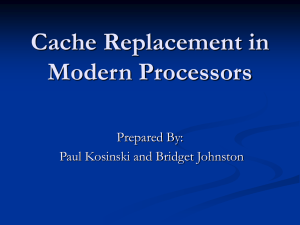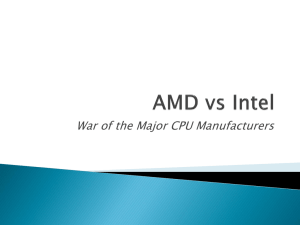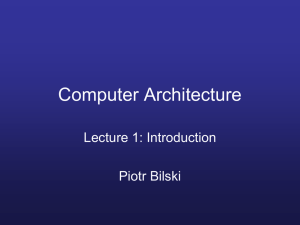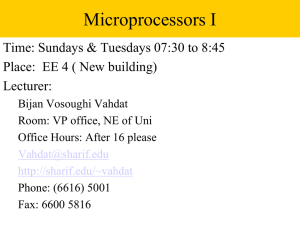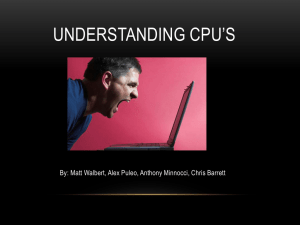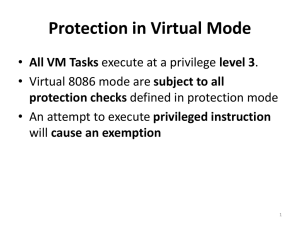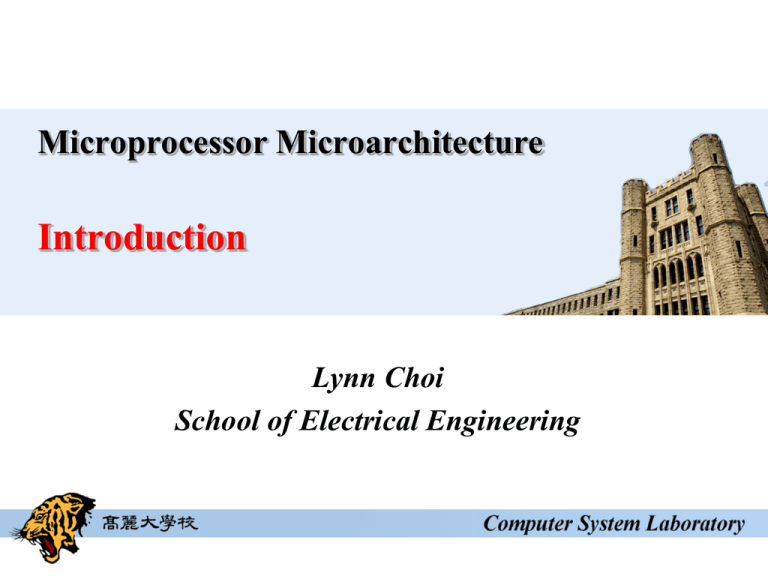
Microprocessor Microarchitecture
Introduction
Lynn Choi
School of Electrical Engineering
Class Information
Lecturer
Prof. Lynn Choi, 02-3290-3249, lchoi@korea.ac.kr
Textbook
Computer Architecture, A Quantitative Approach
5th edition, Hennessy and Patterson, Morgan Kaufmann
Lecture slides (collection of research papers)
Reading list (refer to the class homepage)
Content
Introduction
Branch Prediction
Instruction Fetch
Data Hazard and Dynamic Scheduling
Limits on ILP
Exceptions
Multiprocessors and Multithreading
Advanced Cache Design and Memory Hierarchy
IA64 and Itanium CPU
Class Information
Special Topics
Multicore and manycore processors
Presentation of ~2 papers in the subject
Project
Research proposal
Simulation and experimentation results
Detailed survey
Evaluation
Midterm : 35%
Final: 35%
Presentation: 15%
Project: 15%
Class organization
Lecture: 70%
Presentation: 30% (after Midterm)
Advances in Intel Microprocessors
SPECInt95 Performance
80
81.3 (projected)
Pentium IV 2.8GHz
(superscalar, out-of-order)
70
60
42X Clock Speed ↑
2X IPC ↑
50
45.2 (projected)
Pentium IV 1.7GHz
(superscalar, out-of-order)
40
24
Pentium III 600MHz
(superscalar, out-of-order)
30
3.33
Pentium 100MHz
1
(superscalar, in-order)
80486 DX2 66MHz (pipelined)
20
8.09
11.6
PPro 200MHz
(superscalar, out-of-order)
Pentium II 300MHz
(superscalar, out-of-order)
10
1992
1993
1994
1995
1996
1997
1998
1999
2000
Intel® Pentium 4 Microprocessor
Intel Pentium IV Processor
Technology
0.13 process, 55M transistors, 82W
3.2 GHz, 478pin Flip-Chip PGA2
Performance
1221 Ispec, 1252 Fspec on SPEC 2000
Relative performance to SUN 300MHz Ultra 5_10 workstation (100 Ispec/Fspec)
40% higher clock rate, 10~20% lower IPC compared to P III
Pipeline
20-stage out-of-order (OOO) pipeline, hyperthreading
2 ALUs run at 6.4GHz
Cache hierarchy
12K micro-op trace cache/8 KB on-chip D cache
On-chip 512KB L2 ATC (Advanced Transfer Cache)
Optional on-die 2MB L3 Cache
800MHz system bus, 6.4GB/s bandwidth
Implemented by quad-pumping on 200MHz system bus
Intel® Itanium® 2 processor
Intel® Itanium® 2 processor
Technology
1.5 GHz, 130W
Performance: 1322 Ispec, 2119 Fspec
50% higher transaction performance compared to Sun UltraSPARC III Cu
processor (4-way MP system)
EPIC architecture
Pipeline
8-stage in-order pipeline (10-stage in Itanium)
11 issue ports (9 ports in Itanium)
6 INT, 4 MEM, 2 FP, 1 SIMD, 3 BR (4 INT, 2 MEM in Itanium)
Cache hierarchy
32KB L1 cache, 256KB L2 cache, and up to 6MB L3 Cache
Memory and System Interface
50b PA, 64b VA
400MHz 128-bit system bus, 6.4GB/s bandwidth (compared to 266MHz 64bit system bus, 2.1GB.s in Itanium)
Microprocessor Performance Curve
Today’s Microprocessor
Intel i7 Processor
Technology
32nm process, 130W, 239 mm² die
3.46 GHz, 64-bit 6-core 12-thread processor
159 Ispec, 103 Fspec on SPEC CPU 2006 (296MHz
UltraSparc II processor as a reference machine)
Core microarchitecture
Next generation multi-core microarchitecture introduced
in Q1 2006 (Derived from P6 microarchitecture)
Optimized for multi-cores and lower power consumption
14-stage
4-issue out-of-order (OOO) pipeline
64bit Intel architecture (x86-64)
Core i3 (entry-level), Core i5 (mainstream consumer),
Core i7 (high-end consumer), Xeon (server)
256KB L2 cache/core, 12MB L3 Caches
Integrated memory controller
Intel i7 System Architecture
Integrated memory controller
3 Channel, 3.2GHz clock, 25.6 GB/s
memory bandwidth (memory up to 24GB
DDR3 SDRAM), 36 bit physical address
QuickPath Interconnect (QPI)
Point-to-point processor interconnect,
replacing the front side bus (FSB)
64bit data every two clock cycles, up to
25.6GB/s, which doubles the theoretical
bandwidth of 1600MHz FSB
Direct Media Interface (DMI)
The link between Intel Northbridge and Intel
Southbridge, sharing many characteristics
with PCI-Express
IOH (Northbridge)
ICH (Southbridge)
Intel Corp. All rights reserved
Today’s Microprocessor
Sun UltraSPARC T2 processor (“Niagara II”)
Multithreaded multicore technology
Eight 1.4 GHz cores, 8 threads per core → total 64 threads
65nm process, 1831 pin BGA, 503M transistors, 84W power consumption
Core microarchitecture: Two issue 8-stage instruction pipelines
4MB L2 – 8 banks, 64 FB DIMMs, 60+ GB/s memory bandwidth
Oracle. All rights reserved
Sun UltraSPARC T3 processor (“Rainbow Falls”)
40nm process, 16 1.65GHz cores, 8 threads per core → total 128 threads
Integrated circuit technology
Transistor density: 35%/year
Die size: 10-20%/year
Integration overall: 40-55%/year
DRAM capacity: 25-40%/year (slowing)
Flash capacity: 50-60%/year
15-20X cheaper/bit than DRAM
Magnetic disk technology: 40%/year
15-25X cheaper/bit then Flash
300-500X cheaper/bit than DRAM
Copyright © 2012, Elsevier Inc. All
rights reserved.
Trends in Technology
Trends in Technology
Trends in Technology
Bandwidth and Latency
Bandwidth or throughput
Total work done in a given time
10,000-25,000X improvement for processors
300-1200X improvement for memory and disks
Latency or response time
Time between start and completion of an event
30-80X improvement for processors
6-8X improvement for memory and disks
Feature size
Minimum size of transistor or wire in x or y dimension
10 microns in 1971 to .032 microns in 2011
Transistor performance scales linearly
Integration density scales (more than) quadratically
However, wire delay scales poorly compared to transistor performance!
In the past few years, both wire delay and power dissipation have
become major design limitations for VLSI design
Copyright © 2012, Elsevier Inc. All
rights reserved.
Log-log plot of bandwidth and latency milestones
Copyright © 2012, Elsevier Inc. All
rights reserved.
Trends in Technology
Bandwidth and Latency
Dynamic Power
For CMOS chips, traditional dominant energy consumption
has been in switching transistors, called dynamic power
2
Powerdynamic 1/ 2 CapacitiveLoad Voltage FrequencySwitched
For a fixed task, slowing clock rate (frequency switched) reduces power,
but not energy
Dropping voltage helps both, so went from 5V to 1V
Capacitive load is a function of number of transistors connected to
output and technology determines capacitance of wires and transistors
To save energy & dynamic power, most CPUs now turn off
clock of inactive modules (e.g. FPU)
Example
Suppose 15% reduction in voltage results in a 15%
reduction in frequency. What is impact on dynamic power?
Power dynamic 1/2 Capacitive
Load Voltage FrequencySwitched
2
1/2 Capacitive
Load
(.85 )3 OldPower dynamic
0 .6 OldPower dynamic
2
(.85 Voltage) .85 FrequencySwitched
Static Power
Because leakage current flows even when a transistor is off,
static power important too
Powerstatic Currentstatic Voltage
Leakage current increases in processors with smaller
transistor sizes
In 2006, goal for leakage is 25% of total power consumption;
high performance designs at 40%
Very low power systems even gate voltage to inactive modules
to control loss due to leakage
Processor Performance Equation
Texe (Execution time per program)
= NI * CPIexecution * Tcycle
NI: # of instructions / program (program size)
Small program is better
CPI: clock cycles / instruction
Small CPI is better. In other words, higher IPC is better
Tcycle = clock cycle time
Small clock cycle time is better. In other words, higher clock speed is better
Clock Speed versus Power
Intel 80386 consumed ~ 2 W
3.3 GHz Intel Core i7 consumes 130 W
Heat must be dissipated from 1.5 x 1.5 cm chip
This is the limit of what can be cooled by air
Copyright © 2012, Elsevier Inc. All
rights reserved.
Definition: Performance
Performance(x) =
1
Execution_time(x)
" X is n times faster than Y" means
Performance(X)
n
=
Execution_time(Y)
=
Performance(Y)
Execution_time(X)
Performance: What to measure
Usually rely on benchmarks vs. real workloads
To increase predictability, collections of benchmark
applications, called benchmark suites, are popular
SPECCPU: popular desktop benchmark suite
CPU only, split between integer and floating point programs
SPECint2000 has 12 integer, SPECfp2000 has 14 FP programs
SPECCPU2006 is announced Spring 2006
12 integer and 17 FP programs
Transaction Processing Council measures server performance
and cost-performance for databases
TPC-C Complex query for Online Transaction Processing
TPC-H models ad hoc decision support
TPC-W a transactional web benchmark
TPC-App application server and web services benchmark
SPEC Benchmark Evolution
How Summarize Suite Performance (1/3)
Arithmetic average of execution time of all programs?
But they vary by 4X in speed, so some would be more important than others in
arithmetic average
Could add a weights per program, but how pick weight?
Different companies want different weights for their products
SPECRatio: Normalize execution times to reference computer,
yielding a ratio proportional to performance
=
time on reference computer
time on computer being rated
How Summarize Suite Performance (2/3)
If SPECRatio on Computer A is 1.25 times bigger than
Computer B, then
ExecutionTim ereference
SPECRatioA
ExecutionTim eA
1.25
SPECRatioB ExecutionTim ereference
ExecutionTim eB
ExecutionTim eB Perform ance A
ExecutionTim eA Perform anceB
Note that when comparing 2 computers as a ratio, execution
times on the reference computer drop out, so choice of
reference computer is irrelevant
How Summarize Suite Performance (3/3)
Since we use ratios, proper mean is geometric mean
(SPECRatio unitless, so arithmetic mean meaningless)
Geom etricMean n
n
SPECRatio
i
i 1
Exercises & Discussion
3.2GHz Pentium4 processor is reported to have SPECint ratio of
1221 and SPECfp ratio of 1252 in SPEC2000 benchmarks.
What does this mean?
How much memory can you address using 38 bits of address
assuming byte-addressability?
Classify Intel’s 32bit microprocessors in terms of processor
generations from 80386 to Pentium 4. What’s the meaning of
generation here?
Assume two processors, one RISC and one CISC implemented at
the same clock speed and the same IPC. Which one performs
better?
Homework 1
Read Chapter 1 and Chapter 2
Exercise
1.4
1.5
1.10
1.13
1.18



